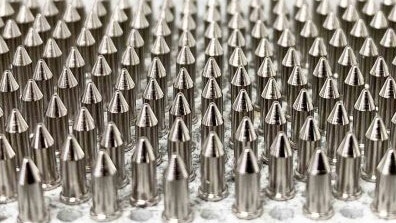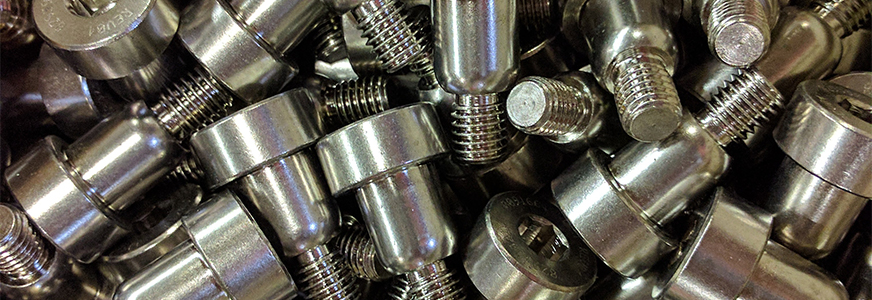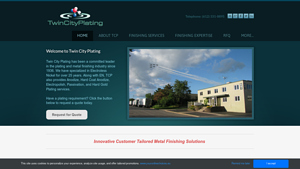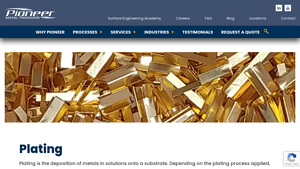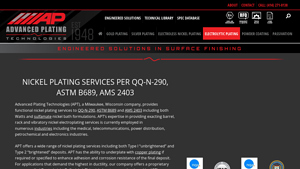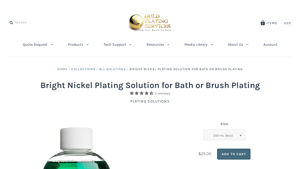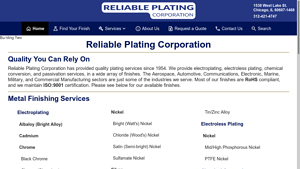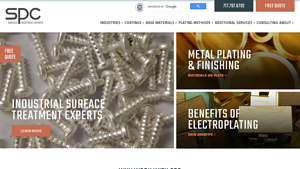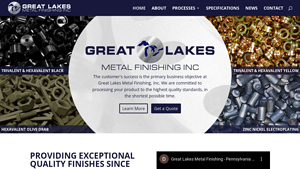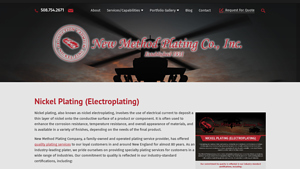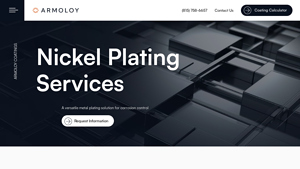Nickel Plating Services Guide: Type, Cost, Top List…
Introduction: Navigating the Global Market for nickel plating services
In today’s competitive global market, sourcing reliable nickel plating services can be a daunting task for B2B buyers, especially those operating in diverse regions such as Africa, South America, the Middle East, and Europe. The challenge lies not only in finding a supplier that meets specific technical requirements but also in ensuring that they adhere to international quality standards and regulations. This guide addresses these complexities by providing a comprehensive overview of nickel plating services, including various types such as electroless and electrolytic nickel plating, as well as their applications across multiple industries.
As you navigate this intricate landscape, you’ll gain insights into key considerations for supplier vetting, including certifications, production capabilities, and past performance. The guide also delves into cost factors, enabling you to make informed decisions that align with your budget and operational needs. By equipping international B2B buyers with actionable knowledge, this resource empowers you to select the right nickel plating service provider that not only enhances product performance but also ensures compliance with regional and global standards. Whether you are in Brazil, Germany, or elsewhere, understanding the nuances of nickel plating services will significantly streamline your procurement process and drive business success.
Understanding nickel plating services Types and Variations
| Type Name | Key Distinguishing Features | Primary B2B Applications | Brief Pros & Cons for Buyers |
|---|---|---|---|
| Electroless Nickel Plating | Autocatalytic process, uniform coating, excellent corrosion resistance | Aerospace, automotive, medical devices | Pros: High uniformity, no need for post-machining. Cons: Slower process than electrolytic methods. |
| Electrolytic Nickel Plating | Uses an electric current, can be brightened or unbrightened | Electronics, telecommunications, power tools | Pros: Faster application, good for large batches. Cons: Less uniformity on complex shapes. |
| Nickel Sulfamate Plating | Highly ductile, low internal stress, matte finish | Automotive, aerospace, electronics | Pros: Excellent solderability, ideal for underplating. Cons: Limited aesthetic appeal due to matte finish. |
| Black Nickel Plating | Secondary treatment for black finish, good conductivity | Decorative applications, electronics, plumbing | Pros: Aesthetic appeal, low reflectivity. Cons: May require additional treatments for corrosion resistance. |
| Hard Nickel Plating | Enhanced hardness and wear resistance | Industrial machinery, tools, and components | Pros: Superior wear properties, ideal for high-stress applications. Cons: Higher cost due to processing complexity. |
What Are the Characteristics of Electroless Nickel Plating?
Electroless nickel plating is an autocatalytic process that deposits a uniform nickel-phosphorus alloy onto substrates without the use of electrical current. This method excels in providing corrosion resistance and wear protection, making it suitable for aerospace, automotive, and medical applications. B2B buyers should consider the slower application speed compared to electrolytic methods, but the advantage of not requiring post-machining can be significant for precision components.
How Does Electrolytic Nickel Plating Differ from Other Types?
Electrolytic nickel plating employs an electric current to deposit nickel onto a substrate, resulting in a bright or unbrightened finish. This method is favored for its speed and efficiency, making it ideal for large-scale production in industries such as electronics and telecommunications. However, the process may yield less uniform coatings on complex geometries, which is a crucial consideration for B2B buyers needing consistent quality across intricate parts.
What Are the Benefits of Nickel Sulfamate Plating?
Nickel sulfamate plating is characterized by its high ductility and low internal stress, resulting in a matte finish that is particularly beneficial for applications requiring solderability. This method is commonly used in automotive and aerospace sectors, where adhesion and corrosion resistance are critical. Buyers should note that while it provides excellent underplating for subsequent layers, its aesthetic limitations may not suit all applications.
Why Choose Black Nickel Plating?
Black nickel plating involves an electrolytic nickel process with a secondary treatment that produces a black finish. This type is popular in decorative applications and industries where low reflectivity is desired, such as plumbing and electronics. While it offers aesthetic benefits, buyers must consider that additional treatments may be necessary to enhance corrosion resistance, potentially increasing overall costs.
What Makes Hard Nickel Plating a Preferred Option?
Hard nickel plating is recognized for its superior hardness and wear resistance, making it ideal for use in industrial machinery and high-stress components. This type of plating is often more expensive due to the complexity of the process, but the long-term durability it provides can justify the investment for B2B buyers focused on performance and longevity in demanding applications.
Key Industrial Applications of nickel plating services
| Industry/Sector | Specific Application of nickel plating services | Value/Benefit for the Business | Key Sourcing Considerations for this Application |
|---|---|---|---|
| Aerospace | Protective coatings for aircraft components | Enhanced corrosion resistance and durability | Compliance with aerospace standards; ability to handle large parts |
| Automotive | Nickel plating for engine components and connectors | Improved wear resistance and electrical conductivity | ISO certifications; experience with high-volume production |
| Electronics | Underplating for connectors and circuit boards | Improved solderability and corrosion protection | Expertise in precision plating; ability to meet RoHS compliance |
| Oil & Gas | Coatings for drilling equipment and valves | Increased longevity and resistance to harsh environments | Capability to handle large and complex geometries; environmental regulations compliance |
| Medical Devices | Nickel plating for surgical instruments and implants | Enhanced biocompatibility and resistance to wear | Certification for medical applications; strict quality control processes |
How Is Nickel Plating Used in Aerospace Applications?
In the aerospace sector, nickel plating is crucial for protecting aircraft components from corrosion and wear. Parts such as landing gear, engine components, and fasteners benefit from nickel’s excellent resistance to harsh environmental conditions. Buyers in this sector must ensure that their plating service provider complies with rigorous aerospace standards and can handle larger components, as many aerospace parts are sizable and complex.
What Role Does Nickel Plating Play in Automotive Manufacturing?
Automotive manufacturers utilize nickel plating for engine components, connectors, and decorative finishes. The plating enhances wear resistance and electrical conductivity, which is vital for the increasing demand for electric and hybrid vehicles. International buyers should seek suppliers with ISO certifications and experience in high-volume production to ensure consistent quality and efficiency in the manufacturing process.
How Is Nickel Plating Beneficial for Electronics?
In electronics, nickel plating serves as an undercoat for connectors and circuit boards, improving solderability and providing corrosion protection. This is particularly important in environments where electronic components are exposed to moisture and other corrosive agents. Buyers should prioritize suppliers with expertise in precision plating and the ability to meet strict RoHS compliance to ensure the safety and reliability of their products.
Why Is Nickel Plating Important for Oil & Gas Equipment?
Nickel plating is widely used in the oil and gas industry for coating drilling equipment and valves to enhance their longevity and resistance to harsh environments. The extreme conditions faced in this sector demand coatings that can withstand high temperatures and corrosive substances. Buyers must consider suppliers who can handle large and complex geometries while ensuring compliance with environmental regulations to mitigate operational risks.
How Does Nickel Plating Enhance Medical Devices?
In the medical device industry, nickel plating is applied to surgical instruments and implants to improve wear resistance and enhance biocompatibility. This is crucial for ensuring the safety and longevity of medical devices used in patient care. Buyers should look for suppliers with certifications specific to medical applications and stringent quality control processes to guarantee that the plating meets all safety and regulatory standards.
3 Common User Pain Points for ‘nickel plating services’ & Their Solutions
Scenario 1: Navigating Quality Control Challenges in Nickel Plating
The Problem: B2B buyers frequently face issues related to the inconsistent quality of nickel plating services. Variability in plating thickness, surface finish, and adhesion can lead to product failures, increased rework, and a tarnished reputation. For companies in sectors such as aerospace or electronics, where precision is crucial, even minor discrepancies can result in significant operational setbacks. The challenge is compounded when sourcing from multiple suppliers across different regions, leading to discrepancies in quality control standards.
The Solution: To mitigate these quality control issues, buyers should prioritize sourcing from ISO-certified providers who adhere to recognized industry standards, such as QQ-N-290 and ASTM B689. It’s essential to request detailed documentation of the supplier’s quality control processes, including batch testing results and compliance with international standards. Establishing clear specifications for nickel plating, including thickness tolerances and performance requirements, will ensure that the service provider understands your quality expectations. Additionally, consider implementing a regular audit schedule for suppliers to verify adherence to these standards and maintain open lines of communication regarding any quality concerns. This proactive approach not only minimizes risks but also fosters a long-term partnership based on reliability and trust.
Scenario 2: Overcoming Delays in Lead Times for Nickel Plating Services
The Problem: Timeliness is a critical factor in manufacturing, and delays in nickel plating services can disrupt production schedules. Buyers often encounter lengthy lead times due to limited plating capacity or unexpected demand surges. This is particularly problematic for industries with tight deadlines, such as automotive or medical devices, where delays can lead to financial losses and missed market opportunities.
The Solution: To address lead time issues, buyers should conduct thorough research on potential plating partners before committing to a contract. Look for suppliers that provide clear timelines and have a proven track record of meeting deadlines. It may be beneficial to establish a strategic partnership with a plating service that can accommodate rush orders or has the capacity for large-scale projects. Negotiating service level agreements (SLAs) that include penalties for missed deadlines can incentivize suppliers to prioritize your orders. Additionally, consider diversifying your supplier base by having multiple plating partners in different regions to reduce the risk of delays caused by capacity constraints or logistical challenges. This strategy not only ensures continuity in your supply chain but also enhances overall operational efficiency.
Scenario 3: Managing Environmental Compliance in Nickel Plating Processes
The Problem: Environmental regulations are becoming increasingly stringent, and B2B buyers must ensure that their nickel plating suppliers comply with local and international environmental standards. Non-compliance can lead to hefty fines, production stoppages, and damage to corporate reputation. Buyers often struggle to navigate the complex landscape of regulations such as RoHS, REACH, and WEEE, which can vary significantly across regions like Europe, Africa, and South America.
The Solution: To effectively manage environmental compliance, buyers should engage with nickel plating services that are transparent about their environmental practices and certifications. Request documentation that outlines the supplier’s compliance with relevant regulations and their waste management processes. Additionally, consider implementing a compliance checklist that includes specific requirements related to hazardous materials, waste disposal, and emissions standards. By working closely with suppliers who prioritize environmental sustainability, buyers can not only mitigate risks associated with non-compliance but also align their operations with global sustainability goals. This proactive stance will not only protect your business from potential penalties but also enhance your brand’s reputation as an environmentally responsible entity in the marketplace.
Strategic Material Selection Guide for nickel plating services
What Are the Key Materials Commonly Used in Nickel Plating Services?
Nickel plating services utilize various materials, each offering distinct properties and performance characteristics. Here, we analyze four common materials used in nickel plating, focusing on their suitability for B2B applications, particularly for international buyers from Africa, South America, the Middle East, and Europe.
1. Stainless Steel: A Versatile Choice for Nickel Plating
Key Properties: Stainless steel exhibits excellent corrosion resistance, high strength, and good temperature tolerance, making it suitable for a wide range of applications. It can withstand pressures up to 1500 psi and temperatures exceeding 800°F.
Pros & Cons: The durability of stainless steel is a significant advantage, as it maintains its integrity in harsh environments. However, its higher cost compared to carbon steel can be a drawback for budget-sensitive projects. Manufacturing complexity is moderate, often requiring specialized equipment for plating.
Impact on Application: Stainless steel is compatible with various media, including chemicals and high-temperature fluids, making it ideal for industries like aerospace and food processing.
Considerations for International Buyers: Buyers should ensure compliance with international standards such as ASTM and DIN. The availability of stainless steel can vary by region, impacting lead times.
2. Aluminum Alloys: Lightweight and Corrosion-Resistant
Key Properties: Aluminum alloys are lightweight with good corrosion resistance and thermal conductivity. They typically operate effectively at temperatures up to 400°F and pressures around 1000 psi.
Pros & Cons: The low weight of aluminum alloys is a significant advantage for applications requiring reduced mass. However, they can be more expensive than traditional steel options and may require additional treatments to enhance adhesion during the nickel plating process.
Impact on Application: Aluminum’s compatibility with various media makes it suitable for automotive and electronics applications, where weight reduction is crucial.
Considerations for International Buyers: Compliance with RoHS and REACH regulations is essential when sourcing aluminum products. Buyers should also consider local availability and potential tariffs on imported materials.
3. Copper and Copper Alloys: Excellent Conductivity
Key Properties: Copper offers outstanding electrical and thermal conductivity, with excellent ductility and malleability. It can handle temperatures up to 200°F and pressures around 800 psi.
Pros & Cons: The primary advantage of copper is its conductivity, making it ideal for electrical applications. However, its susceptibility to corrosion can be a significant limitation, necessitating a nickel underplate for enhanced protection.
Impact on Application: Copper is widely used in electrical components and connectors, where conductivity is critical. The nickel layer provides a barrier against oxidation and corrosion.
Considerations for International Buyers: Buyers must be aware of compliance with standards like ASTM B689 and AMS 2403. The cost of copper can fluctuate significantly based on market conditions, affecting project budgets.
4. Carbon Steel: Cost-Effective and Strong
Key Properties: Carbon steel is known for its high tensile strength and durability, with a typical operating temperature range of up to 600°F and pressure ratings around 1500 psi.
Pros & Cons: Its cost-effectiveness makes carbon steel a popular choice for many applications. However, it is less corrosion-resistant than stainless steel or aluminum, often requiring additional coatings or treatments.
Impact on Application: Carbon steel is suitable for structural applications and components that do not require high corrosion resistance, such as automotive frames and industrial machinery.
Considerations for International Buyers: Buyers should ensure that carbon steel products meet relevant international standards, such as ISO and ASTM. Availability can vary by region, influencing lead times and shipping costs.
Summary Table of Material Selection for Nickel Plating Services
| Material | Typical Use Case for nickel plating services | Key Advantage | Key Disadvantage/Limitation | Relative Cost (Low/Med/High) |
|---|---|---|---|---|
| Stainless Steel | Aerospace components, food processing | Excellent corrosion resistance | Higher cost compared to carbon steel | High |
| Aluminum Alloys | Automotive parts, electronic housings | Lightweight and good thermal conductivity | Higher cost and adhesion challenges | Medium |
| Copper and Alloys | Electrical components, connectors | Outstanding electrical conductivity | Susceptible to corrosion | Medium |
| Carbon Steel | Structural applications, machinery | Cost-effective and strong | Lower corrosion resistance | Low |
This strategic material selection guide provides B2B buyers with essential insights into the materials commonly used in nickel plating services, enabling informed decision-making for their specific applications.
In-depth Look: Manufacturing Processes and Quality Assurance for nickel plating services
What Are the Key Stages in the Nickel Plating Manufacturing Process?
The manufacturing process for nickel plating services involves several critical stages that ensure high-quality finishes and functional properties. The main stages include material preparation, plating, and finishing.
How is Material Prepared for Nickel Plating?
Material preparation is a vital first step in the nickel plating process. This stage typically involves cleaning and surface preparation of the substrate to ensure optimal adhesion. Techniques such as ultrasonic cleaning, acid cleaning, or sandblasting are commonly employed to remove contaminants like oils, greases, or oxidation. The substrate material, which can include metals such as steel, brass, or aluminum, must be free from any surface imperfections to achieve a uniform nickel deposit.
What Techniques Are Used in the Nickel Plating Process?
The nickel plating itself can be performed through various techniques, primarily categorized into electrolytic and electroless nickel plating.
-
Electrolytic Nickel Plating: This method involves submerging the substrate in a nickel sulfate solution, where an electric current is passed through to deposit nickel onto the surface. This process is suitable for larger production runs and provides a bright, reflective finish.
-
Electroless Nickel Plating: Unlike electrolytic plating, this autocatalytic process does not require external power. Instead, it relies on a chemical reaction to deposit nickel. This technique is advantageous for achieving uniform thickness across complex geometries and is particularly effective for components that require excellent wear and corrosion resistance.
After plating, parts may undergo additional finishing processes such as polishing or passivation to enhance surface properties and protect against corrosion.
What Quality Assurance Practices Are Essential for Nickel Plating Services?
Quality assurance (QA) is critical in nickel plating services to ensure that the finished products meet industry standards and customer specifications.
Which International Standards Are Relevant to Nickel Plating Quality Assurance?
For international B2B buyers, understanding the relevant quality standards is crucial. ISO 9001:2015 is a widely recognized standard that outlines quality management systems and principles. Additionally, industry-specific standards may apply, such as CE marking for products sold in Europe, or API standards for oil and gas applications. Compliance with these standards ensures that the nickel plating services meet safety, reliability, and performance criteria.
What Are the Key Quality Control Checkpoints in Nickel Plating?
Quality control checkpoints throughout the manufacturing process help ensure consistent quality. Common checkpoints include:
-
Incoming Quality Control (IQC): Raw materials and substrates are inspected upon arrival to ensure they meet specified requirements.
-
In-Process Quality Control (IPQC): During the plating process, parameters such as temperature, pH levels, and plating thickness are monitored regularly to maintain consistent quality.
-
Final Quality Control (FQC): After the plating is completed, the finished products undergo a final inspection to verify adherence to specifications, including visual inspections and dimensional checks.
How Can B2B Buyers Verify Supplier Quality Control?
B2B buyers seeking nickel plating services should take proactive steps to verify the quality control measures of potential suppliers. Here are some recommended actions:
-
Conduct Supplier Audits: Visiting the supplier’s facility can provide insights into their manufacturing processes and quality assurance practices. This allows buyers to assess compliance with international standards and internal quality protocols.
-
Request Quality Control Reports: Suppliers should be able to provide detailed quality control reports, including results from testing and inspections. This documentation is essential for verifying that products meet industry standards.
-
Utilize Third-Party Inspection Services: Engaging a third-party inspection agency can provide an unbiased assessment of the supplier’s quality practices. These agencies can perform audits and testing, offering an additional layer of assurance.
What Common Testing Methods Are Used to Ensure Nickel Plating Quality?
Several testing methods are commonly employed to assess the quality of nickel plating:
-
Thickness Testing: This is crucial for ensuring that the nickel deposit meets specified thickness requirements. Techniques such as X-ray fluorescence (XRF) or magnetic induction testing are often used.
-
Adhesion Testing: This evaluates the bond strength between the nickel layer and the substrate. Common methods include the tape test and scratch test.
-
Corrosion Resistance Testing: Salt spray tests or cyclic corrosion tests are performed to evaluate how well the nickel plating withstands corrosive environments, which is particularly important for applications in harsh conditions.
How Do Quality Control Nuances Differ for International B2B Buyers?
For international B2B buyers, especially those in regions like Africa, South America, the Middle East, and Europe, understanding the nuances of quality control is essential. Different markets may have specific compliance requirements and standards. For instance:
-
Regulatory Compliance: Buyers should be aware of local regulations regarding materials and environmental impact, particularly in Europe where RoHS and REACH regulations apply.
-
Cultural Considerations: Business practices and expectations around quality may vary by region. Establishing clear communication and understanding local practices can facilitate smoother transactions.
-
Documentation and Traceability: Ensure that suppliers provide comprehensive documentation, including material certifications and traceability records, which are often required for compliance in various international markets.
Conclusion
In summary, the nickel plating manufacturing process encompasses meticulous stages from material preparation to final finishing, each crucial for achieving high-quality outcomes. Quality assurance practices, aligned with international standards and rigorous testing methods, ensure that products meet the necessary specifications for various applications. For B2B buyers, understanding these processes and conducting thorough due diligence on suppliers can lead to successful partnerships and high-quality products tailored to their needs.
Practical Sourcing Guide: A Step-by-Step Checklist for ‘nickel plating services’
Introduction
Navigating the procurement of nickel plating services can be complex, especially for international B2B buyers. This checklist provides a structured approach to ensure you select a reliable supplier that meets your technical and operational needs. By following these steps, you can streamline the sourcing process and make informed decisions that enhance your business operations.
Step 1: Define Your Technical Specifications
Before engaging with potential suppliers, clearly outline your technical requirements for nickel plating. This includes specifying the type of nickel plating (e.g., electroless or electrolytic), thickness, and any particular properties needed (like corrosion resistance or ductility).
– Why it matters: A well-defined specification helps avoid misunderstandings and ensures that the supplier can meet your needs.
Step 2: Research Potential Suppliers
Conduct thorough research to identify potential suppliers who specialize in nickel plating services. Look for companies with a strong reputation and relevant experience in your industry.
– What to consider: Check their website for service offerings, client testimonials, and case studies. Utilize platforms like LinkedIn or industry forums to gather insights.
Step 3: Evaluate Supplier Certifications
Verify that suppliers hold necessary certifications, such as ISO 9001:2015, which indicates a commitment to quality management. Compliance with environmental standards like RoHS and REACH is also essential.
– Importance: Certifications demonstrate a supplier’s adherence to industry standards and regulations, providing assurance of quality and reliability.
Step 4: Request Sample Work
Before finalizing your choice, request samples of previous work or prototypes that utilize the nickel plating services you require. This allows you to assess the quality and consistency of their plating.
– What to look for: Evaluate the finish, thickness, and adherence of the plating. Ensure the samples meet your specifications and expectations.
Step 5: Discuss Lead Times and Capacity
Inquire about the supplier’s lead times and production capacity to ensure they can meet your project deadlines. Understanding their operational capabilities will help you plan accordingly.
– Key considerations: Ask about their ability to handle large orders or rush jobs, especially if your project has tight timelines.
Step 6: Understand Pricing Structures
Request detailed quotes from your shortlisted suppliers to understand their pricing structures. Be clear about what is included in the pricing, such as setup fees, finishing options, and any potential surcharges.
– Why it’s critical: A transparent pricing model allows for better budget planning and helps you avoid unexpected costs down the line.
Step 7: Establish Communication Protocols
Ensure there is a clear communication plan in place for project updates, concerns, and feedback. Identify key contacts from both sides to facilitate smooth interactions throughout the project lifecycle.
– Importance: Effective communication reduces the risk of misunderstandings and fosters a collaborative relationship between you and the supplier.
By following these steps, you can navigate the sourcing process for nickel plating services with confidence, ensuring that you select a supplier that aligns with your business needs and technical requirements.
Comprehensive Cost and Pricing Analysis for nickel plating services Sourcing
What Are the Key Cost Components for Nickel Plating Services?
When sourcing nickel plating services, understanding the cost structure is essential for B2B buyers. The primary cost components include:
-
Materials: Nickel plating requires specific materials, including nickel salts and additives, which can vary in price based on purity and sourcing. High-quality materials often lead to enhanced performance characteristics, impacting the overall cost.
-
Labor: Skilled labor is necessary for both the plating process and post-processing activities. Labor costs can fluctuate based on the complexity of the job, the level of expertise required, and local wage rates.
-
Manufacturing Overhead: This encompasses utilities, facility maintenance, and equipment depreciation. Efficient operations can minimize overhead, but buyers should consider the supplier’s operational efficiency as a cost factor.
-
Tooling: Depending on the specifications, specialized tooling may be required for certain parts. The cost of tooling is often amortized over large production runs, making it a critical factor for high-volume orders.
-
Quality Control (QC): Ensuring compliance with industry standards (e.g., QQ-N-290, ASTM B689) involves rigorous QC measures. This adds to the overall cost but is essential for maintaining product integrity and reliability.
-
Logistics: Shipping and handling costs can vary significantly based on distance, weight, and shipping terms. Understanding the logistics involved can help buyers anticipate additional charges.
-
Margin: Suppliers typically include a profit margin, which can vary based on market competition and the specific services provided.
How Do Pricing Influencers Affect Nickel Plating Costs?
Several factors influence pricing in the nickel plating industry, including:
-
Volume/MOQ: Bulk orders often benefit from reduced per-unit costs. Buyers should inquire about minimum order quantities (MOQs) to leverage better pricing.
-
Specifications/Customization: Custom specifications may lead to increased costs due to the need for specialized processes or materials. Clear communication of requirements is crucial to avoid unexpected expenses.
-
Quality/Certifications: Certifications like ISO 9001:2015 or RoHS compliance can enhance credibility but may also increase costs due to additional compliance measures. Buyers should assess the importance of these certifications relative to their needs.
-
Supplier Factors: The reputation, location, and operational efficiency of the supplier can affect pricing. Suppliers with advanced capabilities may charge more but can provide superior quality or faster turnaround times.
-
Incoterms: Understanding the terms of trade can help buyers anticipate logistics costs. Different Incoterms (e.g., FOB, CIF) determine who bears shipping and insurance costs, impacting the final price.
What Are the Best Negotiation Tips for B2B Buyers?
To maximize value when sourcing nickel plating services, consider the following negotiation strategies:
-
Establish a Total Cost of Ownership (TCO): Evaluate not just the upfront cost but the long-term implications, including maintenance, durability, and potential failures. A lower initial price may lead to higher costs down the line.
-
Leverage Volume: If feasible, consolidate orders to meet MOQs and negotiate better rates. Building a long-term relationship with a supplier can also yield favorable pricing.
-
Request Detailed Quotes: Ask for breakdowns of costs to understand where savings can be achieved. This transparency can aid in negotiations and help identify areas for potential cost reductions.
-
Explore Multiple Suppliers: Don’t settle for the first quote. Engaging multiple suppliers can provide leverage in negotiations and help uncover competitive pricing.
-
Be Culturally Aware: When dealing with international suppliers, understanding cultural nuances can facilitate smoother negotiations and build rapport.
What Should Buyers Know About Pricing Nuances in Different Regions?
International B2B buyers should be aware of regional pricing nuances that can affect costs. For example:
-
Africa and South America: Supply chain constraints and import duties may lead to higher costs. Buyers should factor in logistics and tariffs when evaluating quotes.
-
Middle East: Regional suppliers may offer competitive pricing due to lower labor costs. However, quality assurance and compliance with international standards should remain a priority.
-
Europe (e.g., Germany): High labor costs can lead to higher prices, but the quality of service and adherence to strict regulations can justify the investment.
Disclaimer on Pricing
Prices for nickel plating services can vary widely based on the factors discussed. Buyers should conduct thorough market research and obtain multiple quotes to ensure they are receiving competitive pricing tailored to their specific requirements.
Alternatives Analysis: Comparing nickel plating services With Other Solutions
Understanding Alternatives to Nickel Plating Services
In the world of metal finishing, B2B buyers often seek solutions that offer the best balance of performance, cost, and ease of implementation. Nickel plating services are a popular choice for enhancing corrosion resistance and improving wear characteristics. However, it is crucial to consider alternative methods that may also meet specific project requirements. Below is a comparative analysis of nickel plating services against other viable solutions.
| Comparison Aspect | Nickel Plating Services | Electroless Nickel Plating | Chrome Plating |
|---|---|---|---|
| Performance | Excellent corrosion and wear resistance | Uniform coating on complex shapes | High hardness and wear resistance |
| Cost | Moderate initial investment | Higher due to longer process time | Generally lower, but varies widely |
| Ease of Implementation | Standardized processes available | Requires careful control of conditions | Established processes, but can be hazardous |
| Maintenance | Requires regular inspection | Low maintenance once applied | Requires frequent maintenance |
| Best Use Case | Electrical contacts, automotive parts | Aerospace, medical devices | Decorative applications, heavy machinery |
What are the Advantages and Disadvantages of Electroless Nickel Plating?
Electroless nickel plating is an alternative that employs a chemical reduction process to deposit nickel uniformly across surfaces. This method is particularly beneficial for complex geometries, ensuring that even hard-to-reach areas receive adequate coverage. The main advantage is its ability to create a consistent coating without the need for electrical current. However, the process can be more expensive and time-consuming than traditional nickel plating. Additionally, it may require specialized handling and equipment, which can complicate implementation for some businesses.
How Does Chrome Plating Compare to Nickel Plating Services?
Chrome plating is another popular alternative, known for its aesthetic appeal and superior hardness. It offers excellent wear resistance and is often used in automotive and decorative applications. The process can be less expensive and quicker than nickel plating; however, it poses environmental and health risks due to the chemicals involved. Moreover, chrome plating does not provide the same level of corrosion resistance as nickel plating, making it less suitable for applications where rust prevention is critical.
Conclusion: How Can B2B Buyers Choose the Right Solution?
Choosing the right surface treatment solution requires a thorough understanding of the specific needs of your application. B2B buyers should consider factors such as performance requirements, budget constraints, and the complexity of the parts being treated. While nickel plating services offer a reliable solution for many industries, alternatives like electroless nickel and chrome plating may provide advantages depending on the context. Conducting a comprehensive analysis of these options will enable buyers to make informed decisions that align with their operational goals.
Essential Technical Properties and Trade Terminology for nickel plating services
What are the Critical Technical Properties of Nickel Plating Services?
-
Material Grade
Material grade refers to the specific composition and quality of the nickel used in the plating process. Common grades include electrolytic nickel and nickel sulfamate, each offering distinct properties. For B2B buyers, understanding material grades is essential for ensuring that the plated components meet the required performance standards, especially in demanding applications such as aerospace or medical devices. -
Thickness Tolerance
Thickness tolerance indicates the permissible variation in the thickness of the nickel coating applied to a substrate. Typical ranges can vary from 0.0001 inches to 0.005 inches, depending on the application. This specification is crucial for manufacturers to ensure that parts fit correctly and function effectively, especially in precision engineering where even minor discrepancies can lead to failures. -
Corrosion Resistance
This property measures the ability of the nickel plating to withstand corrosive environments without deteriorating. Nickel plating is often employed to enhance the longevity of components exposed to moisture, chemicals, or extreme temperatures. For international buyers, particularly those in industries like petrochemical or marine, corrosion resistance is a critical factor in reducing maintenance costs and improving product lifespan. -
Ductility
Ductility refers to the ability of the nickel coating to be deformed without breaking. This property is particularly important for applications that require bending or crimping of plated parts, such as in electrical connectors. High ductility ensures that components maintain their integrity during assembly and use, which is a key consideration for B2B buyers in the electronics and automotive sectors. -
Adhesion Strength
Adhesion strength indicates how well the nickel plating adheres to the substrate material. A strong bond is vital to prevent peeling or flaking during service. This property is especially important for components that undergo thermal cycling or mechanical stress. Buyers need to ensure that the chosen plating service meets the required adhesion standards to avoid costly failures.
What are Common Trade Terminologies in Nickel Plating Services?
-
OEM (Original Equipment Manufacturer)
OEM refers to companies that produce parts or equipment that may be marketed by another manufacturer. In the context of nickel plating, OEMs often require specialized plating services to meet their product specifications. Understanding OEM requirements helps buyers ensure that they partner with plating services capable of delivering high-quality, customized solutions. -
MOQ (Minimum Order Quantity)
MOQ is the smallest quantity of a product that a supplier is willing to sell. For nickel plating services, MOQs can vary based on the complexity of the plating process and the materials used. Buyers must be aware of MOQs to manage inventory and production schedules effectively, particularly when sourcing for large-scale manufacturing. -
RFQ (Request for Quote)
An RFQ is a document sent to suppliers to solicit price quotations for specific services or products. B2B buyers should use RFQs when seeking nickel plating services to ensure they receive competitive pricing and detailed information about the services offered, including turnaround times and material specifications. -
Incoterms (International Commercial Terms)
Incoterms are a set of international rules that define the responsibilities of buyers and sellers in international transactions. Understanding Incoterms is essential for B2B buyers, as they clarify who is responsible for shipping, insurance, and tariffs when ordering nickel plating services from suppliers in different countries. -
Electrolytic vs. Electroless Nickel Plating
This terminology distinguishes between two types of nickel plating processes. Electrolytic nickel plating uses an electric current to deposit nickel onto a substrate, while electroless nickel plating relies on a chemical reaction without electricity. Buyers must understand the differences to select the appropriate process based on the desired properties of the finished product.
By familiarizing themselves with these technical properties and trade terminologies, B2B buyers can make informed decisions when engaging with nickel plating service providers, ensuring that their requirements are met efficiently and effectively.
Navigating Market Dynamics and Sourcing Trends in the nickel plating services Sector
What Are the Current Market Dynamics and Key Trends Impacting Nickel Plating Services?
The nickel plating services sector is experiencing significant transformation driven by a combination of global economic factors and technological advancements. As industries worldwide emphasize product durability and performance, the demand for nickel plating—known for its corrosion resistance, wear protection, and aesthetic appeal—continues to rise. Key markets in Africa, South America, the Middle East, and Europe, including Brazil and Germany, are particularly active as they seek to enhance their manufacturing capabilities and meet stringent quality standards.
Emerging trends in the B2B landscape include the increasing adoption of automated plating processes and the integration of digital technologies. Automated systems enhance precision and reduce labor costs, making nickel plating more accessible to manufacturers of varying sizes. Additionally, advancements in electroplating technology allow for more efficient and eco-friendly processes, which are crucial as companies strive to reduce their environmental footprint. International buyers are also gravitating toward suppliers who offer customized solutions, allowing for tailored applications that meet specific industry requirements.
Another significant market dynamic is the growing demand for high-performance coatings in industries such as automotive, aerospace, and electronics. Buyers are now more focused on sourcing nickel plating services that offer superior mechanical properties and adaptability to diverse substrates, including aluminum and stainless steel. This trend highlights the importance of collaborating with suppliers who possess the technical expertise and capabilities to handle complex projects.
How Is Sustainability and Ethical Sourcing Influencing the Nickel Plating Services Sector?
Sustainability has emerged as a critical consideration for B2B buyers in the nickel plating services sector. The environmental impact of traditional plating processes, particularly regarding waste generation and chemical use, has prompted a shift towards more sustainable practices. Many manufacturers are now seeking suppliers who implement eco-friendly processes, such as utilizing less harmful chemicals and optimizing energy consumption in their operations.
Ethical sourcing is equally important as companies strive to build transparent and responsible supply chains. Buyers are increasingly interested in the sustainability credentials of their suppliers, looking for certifications such as ISO 14001, which indicates effective environmental management systems. Furthermore, the use of green materials and processes, such as low-impact nickel baths and recyclable packaging, is becoming a requirement in many procurement policies.
By prioritizing sustainability, B2B buyers not only enhance their corporate social responsibility profiles but also mitigate risks associated with regulatory compliance and potential environmental liabilities. Engaging with suppliers committed to sustainable practices can yield long-term benefits, including improved brand reputation and customer loyalty.
How Has the Nickel Plating Services Sector Evolved Over Time?
The evolution of nickel plating services can be traced back to the early 20th century when the process was primarily used for decorative purposes. As industries began to recognize the functional benefits of nickel plating—such as corrosion resistance and improved surface hardness—the demand for these services expanded significantly. The introduction of electroless nickel plating in the 1970s marked a pivotal moment, allowing for uniform coatings on complex geometries without the need for electrical current.
Over the decades, advancements in technology and materials have refined nickel plating processes, enabling manufacturers to produce higher quality and more durable finishes. The sector has also seen increased globalization, with suppliers from various regions vying for international contracts. This competitive landscape has driven innovation and efficiency, allowing buyers greater access to cutting-edge plating solutions tailored to their specific needs.
As the industry moves forward, the focus on sustainability and ethical sourcing will likely shape the future of nickel plating services, prompting further advancements in technology and process optimization to meet the evolving demands of global markets.
Frequently Asked Questions (FAQs) for B2B Buyers of nickel plating services
1. How do I choose the right nickel plating service provider for my needs?
Selecting the right nickel plating service provider involves evaluating several factors. Start by assessing their experience and expertise in your specific industry, as specialized knowledge can lead to better outcomes. Check for certifications such as ISO 9001:2015, which indicate a commitment to quality. Additionally, request samples of their work to evaluate the quality of their plating. It’s also vital to consider their capacity and turnaround times, ensuring they can meet your project demands.
2. What are the typical applications of nickel plating in various industries?
Nickel plating is widely used across numerous industries due to its corrosion resistance, wear resistance, and aesthetic appeal. Common applications include automotive components, electronics, medical devices, and decorative finishes for consumer goods. In the aerospace and defense sectors, nickel plating is often employed for its durability and ability to withstand harsh environments. Understanding the specific requirements of your application will help in selecting the appropriate nickel plating process, whether it be electroless or electrolytic.
3. What are the minimum order quantities (MOQs) for nickel plating services?
Minimum order quantities (MOQs) for nickel plating services can vary significantly by supplier and the specifics of your project. Some providers may have MOQs as low as a few pieces, while others may require larger batches due to equipment setup costs. It’s advisable to discuss your needs directly with potential suppliers to understand their MOQ policies. This will help you align your purchasing strategy with your production needs and budget.
4. How can I ensure quality assurance in nickel plating services?
To ensure quality assurance in nickel plating services, choose a provider that follows stringent quality control processes. Look for suppliers who are ISO certified, as this indicates adherence to international quality standards. Request detailed information about their QA procedures, including inspection methods and testing protocols for thickness, adhesion, and corrosion resistance. Additionally, asking for documentation such as certificates of compliance can help verify that the plating meets required specifications.
5. What payment terms are typically offered by nickel plating service providers?
Payment terms for nickel plating services can vary widely based on the supplier’s policies and the nature of the contract. Common arrangements include upfront payments, deposits, or net terms (e.g., net 30 or net 60). For international transactions, it’s crucial to discuss currency options, potential import duties, and payment methods such as letters of credit or wire transfers. Clear communication regarding payment terms will help avoid misunderstandings and ensure smoother transactions.
6. How does international shipping work for nickel plating services?
International shipping for nickel plating services requires careful planning and coordination. It’s essential to confirm that your chosen supplier is experienced in shipping to your location, as they should be familiar with customs regulations and logistics. Discuss shipping options, including costs, delivery times, and insurance coverage. Ensure that the supplier provides proper documentation for customs clearance, as this will facilitate the smooth importation of your plated components.
7. Can nickel plating services be customized for specific project requirements?
Yes, many nickel plating service providers offer customization options to meet specific project requirements. This can include variations in plating thickness, finishes (e.g., bright vs. dull), and even the choice between electroless and electrolytic nickel plating. When discussing your project, provide detailed specifications and any unique performance criteria needed. A reputable supplier will work with you to develop tailored solutions that align with your application needs.
8. What are the environmental considerations for nickel plating processes?
Environmental considerations are increasingly important in nickel plating processes. Many suppliers are adopting eco-friendly practices, such as using less toxic chemicals and implementing waste recycling programs. When sourcing nickel plating services, inquire about the supplier’s compliance with environmental regulations like RoHS and REACH. Additionally, understanding their waste management practices and commitment to sustainability can ensure that your project aligns with both ethical standards and regulatory requirements.
Important Disclaimer & Terms of Use
⚠️ Important Disclaimer
The information provided in this guide, including content regarding manufacturers, technical specifications, and market analysis, is for informational and educational purposes only. It does not constitute professional procurement advice, financial advice, or legal advice.
While we have made every effort to ensure the accuracy and timeliness of the information, we are not responsible for any errors, omissions, or outdated information. Market conditions, company details, and technical standards are subject to change.
B2B buyers must conduct their own independent and thorough due diligence before making any purchasing decisions. This includes contacting suppliers directly, verifying certifications, requesting samples, and seeking professional consultation. The risk of relying on any information in this guide is borne solely by the reader.
Top 10 Nickel Plating Services Manufacturers & Suppliers List
1. Twin City Plating – Electroless Nickel Specialists
Domain: twincityplating.com
Registered: 2000 (25 years)
Introduction: Twin City Plating (TCP) offers the following plating and metal finishing services: Electroless Nickel Plating, Electroless Nickel Composite Plating, Anodize, Hard Coat Anodize, Chem Film, Passivation, Electropolishing, and Hard Gold Plating. TCP specializes in Electroless Nickel and has been in the industry since 1936, with over 25 years of experience in this specific service. The company is ISO 9…
2. Pioneer Metal – Black Nickel Plating
Domain: pioneermetal.com
Registered: 1997 (28 years)
Introduction: Plating Services: Gold, Silver, Electrolytic Nickel, Black Nickel, Copper Plating, Electroless Nickel, Functional Hard Chrome.
1. **Black Nickel**:
– Type: Electrolytic nickel plating with secondary treatment.
– Benefits: Corrosion resistance, electrical conductivity, low reflectivity.
– Specifications: MIL-P-18317, RoHS, REACH, ELV & WEEE compliant.
– Thickness: .0001-.005″ (100…
3. Advanced Plating Technologies – Nickel Plating Services
Domain: advancedplatingtech.com
Registered: 2013 (12 years)
Introduction: Nickel Plating Services provided by Advanced Plating Technologies (APT) include functional nickel plating services compliant with QQ-N-290, ASTM B689, and AMS 2403. APT offers both Watts and sulfamate nickel bath formulations, with expertise in barrel, rack, and vibratory nickel electroplating. Services include Type I “unbrightened” and Type II “brightened” deposits. APT can underplate with copper…
4. Gold Plating – Bright Nickel Plating Solution
Domain: goldplating.com
Registered: 1996 (29 years)
Introduction: Bright Nickel Plating Solution for Bath or Brush Plating
– Sizes Available: 250 mL (8oz), 500 mL, 1000 mL/Liter, 1 Gallon, 2 Gallons, 3 Gallons, 4 Gallons
– Prices: 250 mL – $25.00, 500 mL – $45.00, 1000 mL – $75.00, Gallon – $250.00, 1 Gallon + 1000 mL – $300.00, 2 Gallons – $460.00, 3 Gallons – $675.00, 4 Gallons – $890.00
– Description: Electroplating solution designed to plate a hard, bright …
5. SendCutSend – Customizable Metal Plating Services
Domain: sendcutsend.com
Registered: 2015 (10 years)
Introduction: Fast sheet metal plating services with no minimum quantity. Customizable zinc and nickel plating available. Options include clear, black, or yellow zinc, and bright nickel finishes. Pricing starts at $0.50 per part in bulk. Suitable for copper, chromoly, and mild steel. Guaranteed quality with a refund or remake policy. Zinc plating options: Black Zinc, Clear Zinc, Yellow Zinc, all conforming to A…
6. Reliable Plating Corporation – Metal Finishing Services
Domain: reliableplating.com
Registered: 1996 (29 years)
Introduction: Reliable Plating Corporation offers a range of metal finishing services including electroplating, electroless plating, chemical conversion, and passivation. Their electroplating finishes include Albaloy (Bright Alloy), Cadmium, Chrome (including Black Chrome and Microporous Chrome), Copper, Gold, various Nickel finishes (Bright, Chloride, Satin, Sulfamate), Silver, Tin (Bright, Dull, Tin/Zinc Allo…
7. Sharretts Plating – Key Product Details
Domain: sharrettsplating.com
Registered: 2001 (24 years)
Introduction: Key Product Details: 1. Industries Served: 3D Printing, Aerospace, Automotive, Defense, Electronics, Medical, Oil & Gas, Optics, Power Generation, Semiconductors. 2. Plating Materials: Gold, Silver, Nickel, Electroless Nickel-Boron, Electroless Nickel-Phosphorus, Palladium, Platinum, Rhodium, Ruthenium, Tin, Copper. 3. Base Materials: Plastics (ABS, PPA, SLS, SLA), Ceramics, Glass, Copper, Aluminu…
8. Great Lakes Metal Finishing – Zinc & Nickel Electroplating Services
Domain: goglmf.com
Registered: 1999 (26 years)
Introduction: Great Lakes Metal Finishing, Inc. specializes in zinc and zinc nickel electroplating services, offering trivalent black, hexavalent black, trivalent yellow, trivalent clear, and olive drab finishes. They provide corrosion resistance, scratch and wear resistance, electrical insulation, cleanliness, and aesthetic enhancement. The company is certified with ZinKlad standards, ensuring RoHS compliance …
9. New Method Plating – Nickel Electroplating Solutions
Domain: newmethodplating.com
Registered: 1999 (26 years)
Introduction: Nickel Plating, also known as nickel electroplating, involves depositing a thin layer of nickel onto conductive surfaces using electrical current. Benefits include enhanced corrosion resistance, resistance to outdoor elements, improved conductivity, high hardness and material stability, improved tensile strength, enhanced wear resistance, improved ductility, even coating, and customizable finished…
10. Armoloy – Nickel Plating Services
Domain: armoloy.com
Registered: 1997 (28 years)
Introduction: Armoloy Nickel Plating Services provide a versatile metal plating solution for corrosion control, utilizing nickel, a hard and ductile transition metal known for its corrosion and wear resistance. The nickel coatings are applied through an electroplating process, enhancing the lifespan and appearance of components. Key offerings include mid-phosphorus electroless nickel, known for uniform depositi…
Strategic Sourcing Conclusion and Outlook for nickel plating services
In the rapidly evolving landscape of nickel plating services, strategic sourcing emerges as a critical component for international B2B buyers. By understanding the diverse applications of nickel plating—from enhancing corrosion resistance to improving electrical conductivity—companies can better align their sourcing strategies with their operational needs. Engaging with reputable suppliers who offer customized solutions, such as electroless nickel and sulfamate nickel processes, ensures that businesses benefit from high-quality finishes tailored to their specifications.
As global markets in Africa, South America, the Middle East, and Europe continue to expand, the importance of selecting the right plating partner cannot be overstated. Buyers should prioritize suppliers that demonstrate industry certifications, such as ISO 9001:2015, and have experience across various sectors including telecommunications, medical, and automotive.
Looking ahead, fostering relationships with innovative plating service providers will not only enhance product quality but also drive competitive advantage. Now is the time for international buyers to explore strategic partnerships that can elevate their manufacturing capabilities. Engage with a trusted nickel plating service provider today to secure your position in the market and unlock new growth opportunities.
